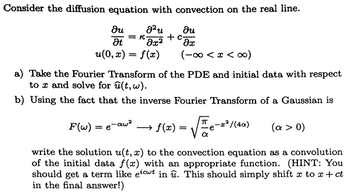
Algebra & Trigonometry with Analytic Geometry
13th Edition
ISBN: 9781133382119
Author: Swokowski
Publisher: Cengage
expand_more
expand_more
format_list_bulleted
Question
thumb_up100%

Transcribed Image Text:Consider the diffusion equation with convection on the real line.
მu.
at
= K
J²u
მ2
მu.
+ C-
მე
u(0,x) = f(x)
(∞0>x>∞0-)
a) Take the Fourier Transform of the PDE and initial data with respect
tox and solve for u(t, w).
b) Using the fact that the inverse Fourier Transform of a Gaussian is
F(w) = e-aw²
f(x) =
-x²/(4α)
(a > 0)
write the solution u(t, x) to the convection equation as a convolution
of the initial data f(x) with an appropriate function. (HINT: You
should get a term like eicut in u. This should simply shift x to x + ct
in the final answer!)
Expert Solution
This question has been solved!
Explore an expertly crafted, step-by-step solution for a thorough understanding of key concepts.
Step by stepSolved in 2 steps with 3 images

Knowledge Booster
Similar questions
- A bee with a velocity vector r' (t) starts out at (7, -3, 7) at t = 0 and flies around for 6 seconds. Where is the bee located at time t = 6 if [°r' (Use symbolic notation and fractions where needed.) r' (u) du = 0 location:arrow_forwardFind the linearization at x=a and then use it to approximate f(b) 1.) f(x)=x4, a=1, b=0.96 2.) f(x)=sin2x, a=pie/4, b=2.02arrow_forwardShow that t, e^t, and sin(t) are linearly independent.arrow_forward
- Which of the following pair of functions is linearly independent? (а) еЗx, е(х-3) (b) 4, sin?x + cos?x (c) 2sin2x, sinxcosx (d) sinhx, (e* – e*)arrow_forwardHarrow_forwardExpress dw/ðu and əw/dv as functions of u and v both by using the Chain Rule and expressing w directly in terms of u and v before differentiating. w = In(x? + y? + z²), x= e" sinu, y=e" cos u, z= ue ": (u,v) = (-2,0)arrow_forward
- the linearization of (fi,f2) = (x²y+ 3xy², 3x³ + 2xy) at (1,0) to approximate the value at (0.9,-0.1).arrow_forwardEX: Find the F.T. of the triangular pulse: g(t) = AA (+) Sols Apply differentiation property of F-T g(t) = 2A S(t+1)_4A S(t) + 2A S(t-I) The F. I for the both sides gives. (jw)² G (w) = 2A (NE_2 +2²) (e j들 (JW)³&(W) = 4A (2 ² + 2² (e 2 G(W) = -4A whe - 8A w²t -₁) 8A ( cos 뜰 -1) = 82 (1-005) 2 sin wt 4 At sin wt 2 Wt 4 2 3/4 N 2A T ZA 0 0 8(1)-A(+) =9c How did he get the value inside the circle Hes -9C2A ہم تم at otarrow_forwardFind the velocity and acceleration vectors and the equation of the tangent line for the curve r(t) = √3ti + e¹¹j + 6e¯¹k at t = 0. (Use symbolic notation and fractions where needed. Give your answers in the form (*,*,*).) v(0) = a(0) = (Use symbolic notation and fractions where needed. Give your answers in the form (*,*,*). Use t for the parameter that takes all real values.) 1(t)arrow_forward
- Determine whether the pairs of the functions are linearly inde-pendent or linearly dependent on the real line. f(x) = e^x sin(2πx), g(x) = e^x cos(2πx)arrow_forwardFind the Fourier transform of sinc (2t). (a) 2n A(w/2) 3. (b) п Д(u/4) A(w/8 (d) A(w/16) Moving to the next ouestion.prevents changes to chis anaWerarrow_forwardFind the velocity and acceleration vectors and the equation of the tangent line for the curve r(t) = 3 cos(t)i + sin(6t)j at t 0. (Use symbolic notation and fractions where needed. Give your answer in the form (*,*).) v(0) 1(t) = Incorrect (0,6) (Use symbolic notation and fractions where needed. Give your answer in the form (*,*). Use t for the parameter that takes all real values.) = a(0) = (3,0) +t(0,6) (-3,0)arrow_forward
arrow_back_ios
SEE MORE QUESTIONS
arrow_forward_ios
Recommended textbooks for you
- Algebra & Trigonometry with Analytic GeometryAlgebraISBN:9781133382119Author:SwokowskiPublisher:Cengage

Algebra & Trigonometry with Analytic Geometry
Algebra
ISBN:9781133382119
Author:Swokowski
Publisher:Cengage